If you network a lot, you likely have dozens of business cards in different bags, pockets, and wallets. But when you’re looking for something about the same size and thickness as a business card?

It becomes clear how alike most business cards have come to look.

As a company rep or prospective employee, you need to stand out from the pile. So, we’ve gathered business card examples based on insights from marketing managers, recruiters, and decision-makers to help.
5 Good Business Card Examples To Help Get You Started
12 Business Cards for Company Reps
12 Business Cards for Prospective Employees
11 Creative (and Useful) Business Card Ideas
5 Business Card Examples To Help Get You Started
1. A Captivating Tagline

Image Source
Expert Insights
One key element that David Bitton, co-founder and CMO of DoorLoop, looks for in a business card is “a captivating tagline that captures the essence of their offerings.”
That’s because “it’s crucial that a card clearly communicates what makes someone stand out and why I should be interested in engaging with them,” says Bitton.
David suggests a tagline that’s concise and easy to understand. But to steer clear of “clichés and exaggerated claims.” Instead, opt for something that uses originality to spark people’s curiosity while showing a clear understanding of your target market.
2. A Snippet of Uniqueness

Image Source
Expert Insights
“What I crave on a business card is a taste of their personal brand,” says Chris Kille, the entrepreneur behind Payment Pilot.
Besides someone’s “obligatory name and contact details,” Kille looks for “a snippet of their uniqueness.” That could be a memorable tagline or “even a graphic that embodies their spirit.”
Kille believes this is a way to turn business cards into mini billboards that say, “Hey, this is who I am, and this is what I bring to the table!”
3. Testimonials or Recommendations

Image Source
Expert Insights
“Including a brief testimonial or recommendation from a satisfied client or colleague can be a powerful addition to your business card,” says Jeff Wenzel, vice president of marketing and crowdfunding at KoreConx.
Testimonials work because “the positive feedback builds credibility and reinforces the value you bring to the Table.” Wenzel recommends “a concise and impactful testimonial highlighting your expertise and the results you deliver.”
4. Essential Contact Information

Image Source
Expert Insights
“The #1 thing I look for on a business card is essential contact information,” says Coty Perry, chief marketing officer at Anglers.com.
“That may seem like an obvious ask, but trust me—these days, it’s really not,” continues Perry. “People are so wrapped up in the idea of having physical media in a digital-first world. They often forget that value comes down to function as well as form.”
Perry recommends getting the basics right before being “overly clever.” So don’t forget to include your name, position, email, and LinkedIn profile or website URL.
Perry also says to keep it simple, with “no more than three avenues of communication.”
5. Brand Consistency
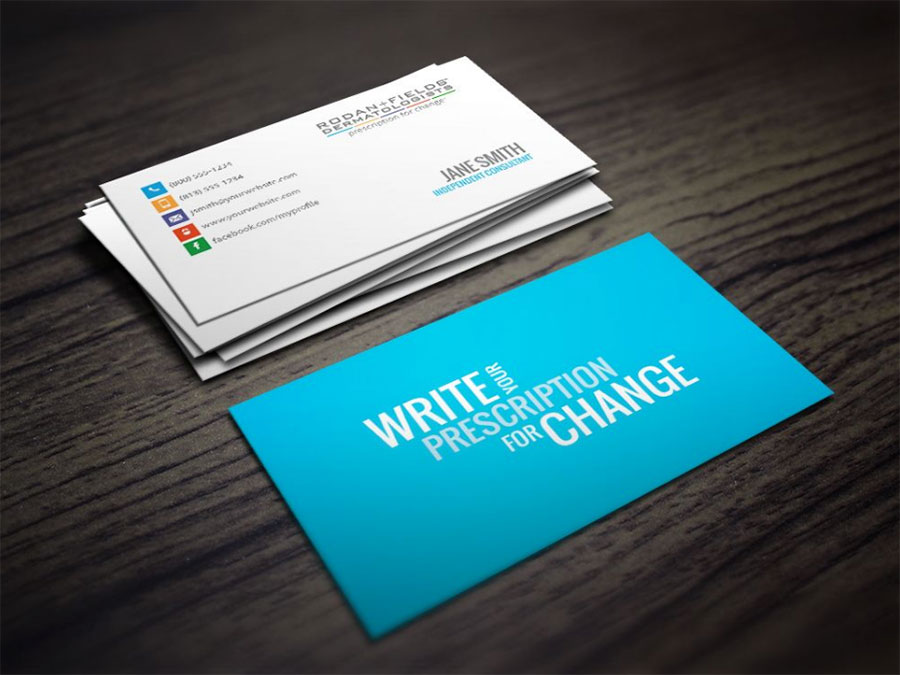
Image Source
Expert Insights
“I appreciate when business cards incorporate branding elements like the logo, color scheme,
or tagline,” says Amelia Thomas, head of marketing at FlexiPCB.
Adding these elements reinforces brand consistency and helps Thomas better “remember the organization associated with the card.”
12 Business Cards for Company Reps
1. QR Code

Image Source
Expert Insights
Nelson Brassel, head of business development at Ten Speed, appreciates company reps having a QR code on their business cards.
That lets him save someone’s information without needing “to hold onto the physical card after the initial face-to-face interaction.”
Social profiles, personal websites, and digital versions of business cards are examples of information Brassel has saved after scanning a QR code.
2. Telling the Brand’s Narrative

Image Source
Expert Insights
“For business cards, it‘s important that you include the company logo and tagline that effectively tells the brand’s narrative,” says Alex Csedrik, marketing manager for Jack Lingo Asset Management.
The logo and tagline should describe what you do as a company rep “in a succinct way.” Csedrik warns this is essential “because every point of contact someone has with your brand is an opportunity to tell your brand’s narrative.”
3. A Tactile Experience

Image Source
Expert Insights
Goran Paun, principal creative director at ArtVersion, has seen trends come and go and digitalization sweep across all marketing sectors. Yet, “there remains something inherently effective about a well-crafted business card,” says Paun.
Paun recommends experimenting with the quality of the paper and enhanced printing techniques, such as letterpress or engraved stationery.
These elements can “elevate a business card from a mere information carrier to a memorable, tactile experience for the recipient.”
4. Embossed Lettering

Image Source
Expert Insights
“Embossed lettering, in my opinion, can make your card look classy and contemporary,” says Gerrid Smith, director of e-commerce at Joy Organics. Adding foil stamping can also help your card stand out at networking events.
But Smith recommends only stamping “any particularly crucial information, such as your organization‘s name, on your company’s business card.” That will stop your card from looking cluttered and unorganized.
5. Traditional Card Dimensions

Image Source
Expert Insights
“Convenience rules. I think you shouldn’t give out your whole résumé at marketing gatherings,” says Starandlink Founder Royal Hernandez.
“Business cards are supposed to fit in a wallet but display important data.” Hernandez reiterates that standard cards are 3.5 inches by 2 inches.
But “you can make your cards bigger or smaller as long as they‘re able to remain functional and fit in someone’s pocket.”
Hernandez says to make sure that when the recipient folds back or cuts the raised edge, “critical information is within traditional card measurements.”
6. Invoke a Positive Memory

Image Source
Expert Insights
“There was a time in the 2000s when people wanted to be Creative with what was on their business cards,” says Black Rabbit’s Head of Creative Wojtek Jeżowski.
So, “instead of ‘Account Manager,’ we might have seen ‘Orchestrator of Client Success and Advertising Solutions.’”
But Jeżowski sees a business card-like advertising, with the best kind being simple. Also, like advertising, “whether that business card invokes a positive memory of your person” matters.
After a networking event, “there will be a large stash of cards on a table somewhere, and it won’t matter how flashy it is,” says Jeżowski. People will care more about how they “felt about something” when they need to make a decision.
7. Handwritten Personalisation
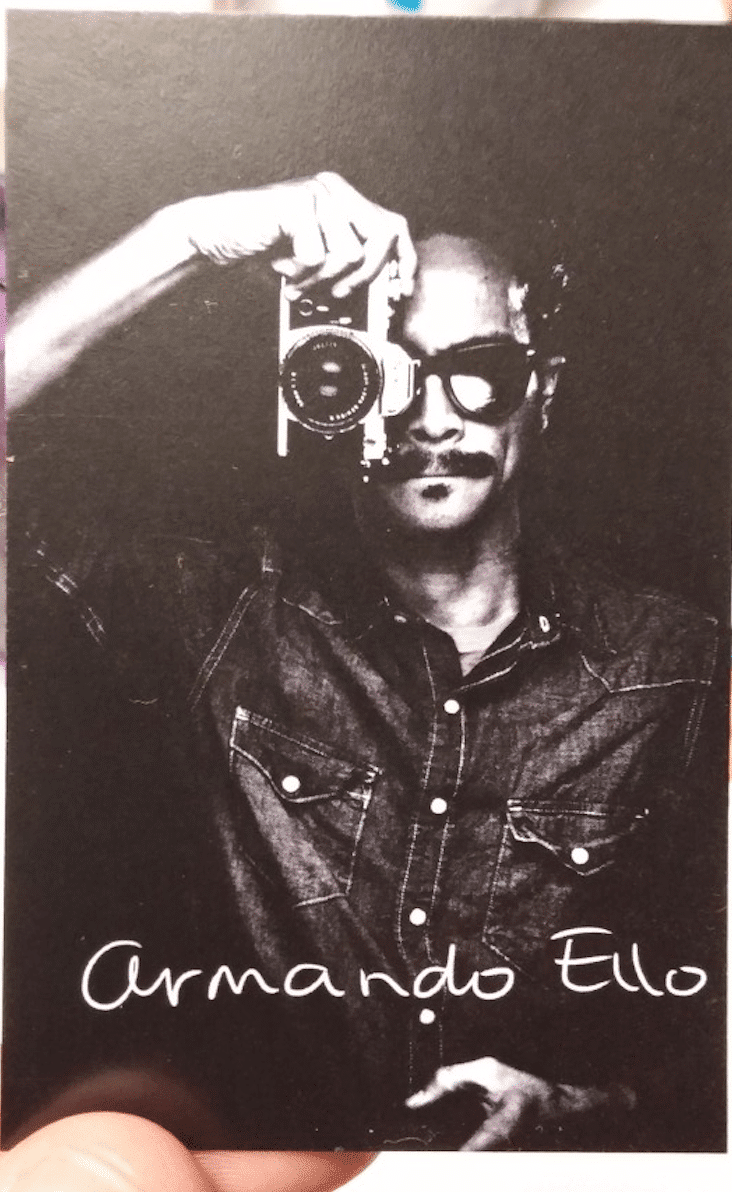
Image Source
Expert Insights
“When I receive business cards, the ones that really stand out to me usually have a personal touch,” says 201 Creative Co-Founder Jared Bauman.
It could be as simple as “a handwritten note or a signature in pen on each card.” Bauman likes this approach because it adds a human element and shows someone put thought into their introduction.
When receiving cards from vendors, Bauman also appreciates a notes section.
“It may seem like a small thing, but this feature can make your card stand out from the pile,” says Bauman.
The section also helps during follow-ups because it’s “great for jotting down context or personal reminders” shortly after meeting someone.
8. Eco-Friendly Business Card

Image Source
Expert Insights
“In an era dominated by digital interactions, a business card remains a tangible reminder of a first meeting,” says Teresha Aird, co-founder and chief marketing officer at Offices.net.
“For me, it is not just about contact information, but also about conveying personality and professionalism.” Aird says your card should reflect “the character, expertise, and uniqueness that you bring to your role and industry.”
Your choice of materials is one way to do that.
Aird pays attention to reps “who are mindful of sustainability, choosing eco-friendly business card materials” because it demonstrates “their commitment to environmental responsibility.”
9. Cool Graphic Design

Image Source
Expert Insights
“I’m pretty particular about what I like to see on a business card,” says Will Yang, head of growth and customer success at Instrumentl.
“One of my favorite cards was from a salesperson who had a really cool graphic design,” recounts Yang.
The card looked like “an old-fashioned robot stamp with some text over top of it.” But their contact information was also in “really nice lettering that was easy to read and understand.”
“It showed both sides of their personality,” says Yang. “One side was fun and quirky; the other side showed them being professional and knowledgeable about their industry.”
10. Simple and Clean

Image Source
Expert Insights
Kieran Sheridan, founder and co-owner of GulfPhysio, likes to see a business card “that is well-designed, but not too ostentatious.”
“The goal of a business card is to convey information about who you are and what you do quickly and easily; it shouldn’t take more than a second or two to read,” says Sheridan.
Sheridan recommends keeping your card simple and clean, with the most critical information being “clear and visible at a glance.”
According to Sheridan, essential information includes your name, title, company name (if applicable), and contact information.
11. Interactive Elements
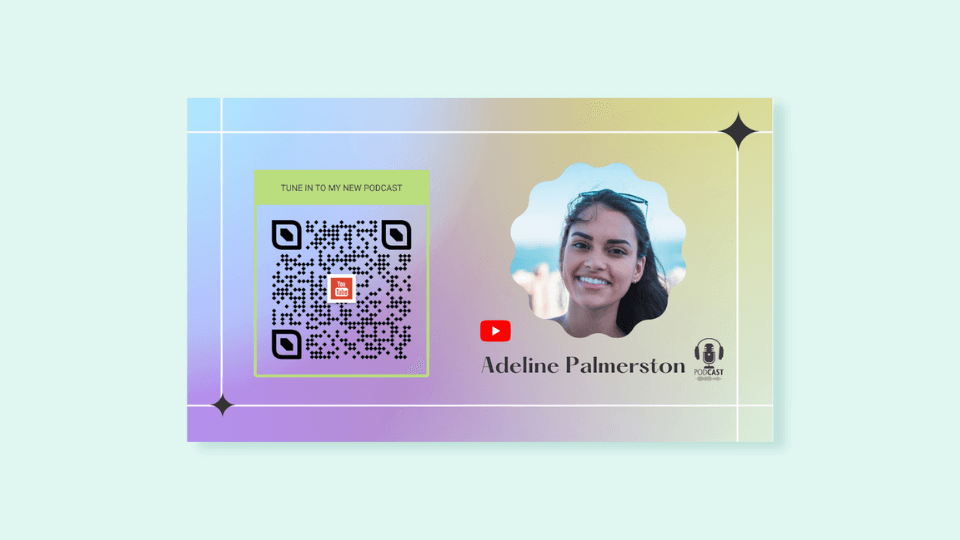
Image Source
Expert Insights
Derrick Hathaway, a sales director at VEM Medical, finds interactive elements on business cards “particularly intriguing.”
Hathaway remembers a recent example of receiving a card that “had a scannable QR code leading to a personalized video message from the individual.”
“This interactive touch not only showcased their technological savvy but also allowed me to connect with them on a more personal level,” says Hathaway.
12. Certifications

Image Source
Expert Insights
Ricky Allen, the marketing director of Ever Wallpaper, says a logo and contact information are “essential for creating an excellent first impression.”
But it’s also essential to include any certifications you or your company may have. That’s because they show whether you or your company has “the necessary skill set” a prospect needs to meet business goals.
12 Business Cards for Prospective Employees
1. Job Title

Image Source
Expert Insights
“I believe that business cards are an excellent way to make a good first impression while networking,” says Jaden Oh, CMO and founder at Traffv.
In particular, business cards for prospective hires should “include relevant information such as a job title.” Including a job title immediately shows a potential employer your specialism and helps to “form a positive impression.”
2. Social Media Handles
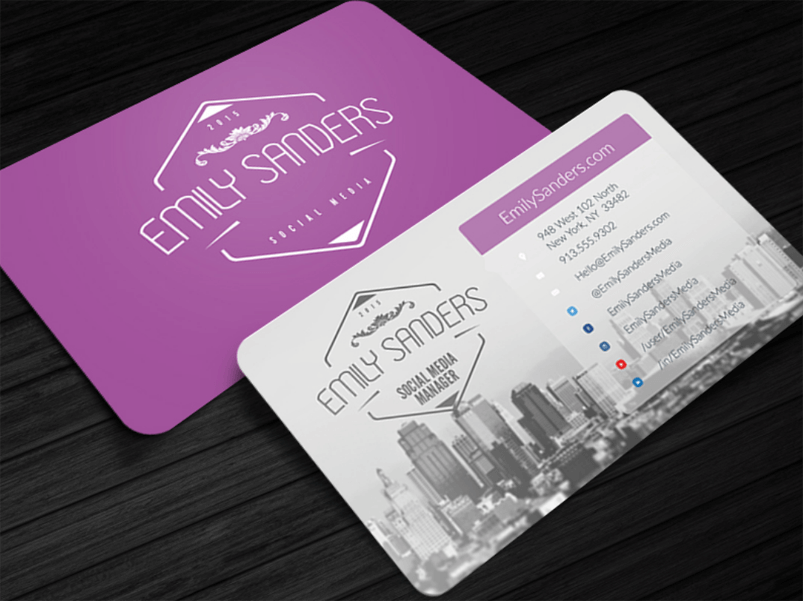
Image Source
Expert Insights
Henry Waddilove, managing director of Novus BC, says it’s vital for potential full-time hires to include important information that shows their “professional identity.”
Waddilove says this applies whether the business cards are for internal or external use.
A key element to include on your card is “the handles or links to your social media profiles.” But Waddilove warns you should exercise caution by making sure the platforms you include “highlight your work or experience.”
3. Skills and Experience

Image Source
Expert Insights
“When it comes to business cards, I like to see clear, concise information that tells me what the person or service does and how they can help me,” says WallPanels’ Founder Christian Sculthorp.
For prospective employees, that means seeing if people have “the skills and experience to help my business grow.” Elements like a job title or a specific accreditation can quickly showcase your skills and experience.
4. LinkedIn Account

Image Source
Expert Insights
“There are several key elements that belong on a business card,” says Cody Candee, founder and CEO of Bounce. “But the one that I immediately look for with prospective hires is their LinkedIn address.”
“Having the basics such as a name, business website, and phone number are a given,” explains Candee.
But a “LinkedIn account on a business card indicates a candidate who is not hesitant to show off their full qualifications, reviews, past experience, as well as their continuous involvement in your industry.”
That transparency sends a message of confidence.
5. A Touch of Creativity and Personalization

Image Source
Expert Insights
“What I personally appreciate seeing on business cards from prospective employees is a touch of creativity and personalization,” says Nikita Sherbina, co-founder & CEO at AIScreen.
Sherbina cites unique designs, memorable taglines, or even a small personal anecdote of ways to showcase your personality as a prospective hire.
For Sherbina, creativity and personalization “leave a lasting impression and sparks curiosity, making the encounter more memorable.”
6. QR Code to Digital Portfolio

Image Source
Expert Insights
“As an entrepreneur, business cards still hold significant sway for me, even in this digital era,” says Erin LaCkore, founder at LaCkore Couture.
LaCkore recommends adding “a QR code to a digital portfolio” on your business card. It’s “an excellent modern touch, showcasing the candidate’s understanding of blending traditional and digital marketing,” explains LaCkore.
7. Unique Selling Proposition (USP)
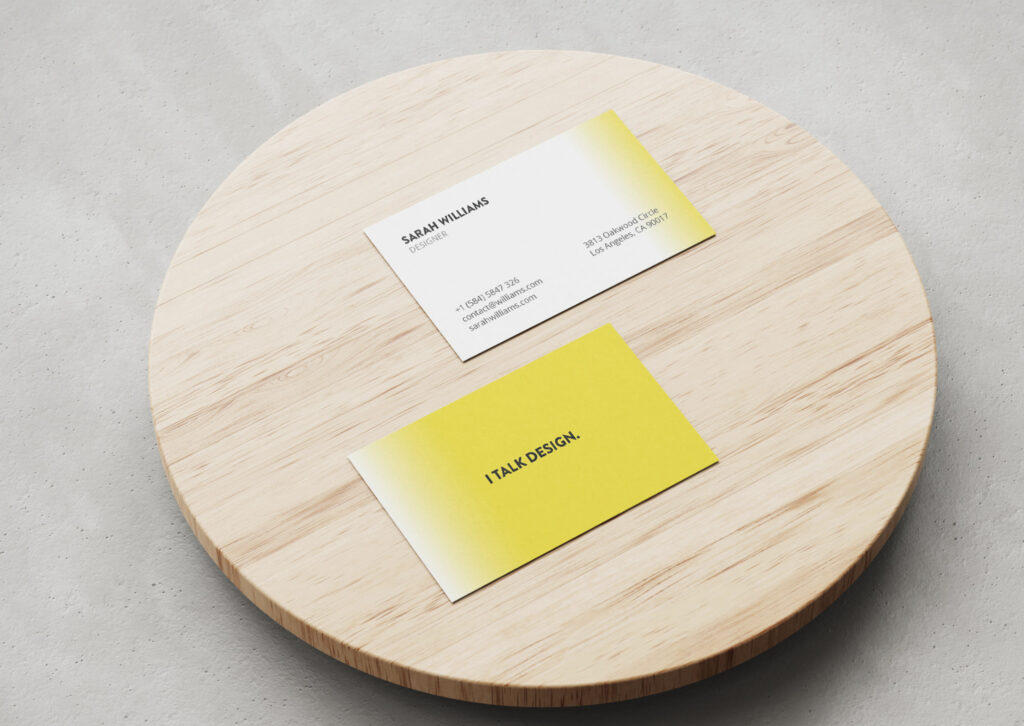
Image Source
Business cards need a unique selling proposition. Aquick catchphrase or remark can show your unique value or specialization helps to create interest. Will help differentiate you from the competition.
8. Embedded NFC Chip

Image Source
Expert Insights
Steve West, Founder of Entrepreneur Nut, appreciates business cards with an embedded NFC (Near Field Communication) chip.
“When tapped with a compatible device, it can automatically trigger actions like opening a resume, displaying a demo reel, or launching a personalized landing page, showcasing your skills and projects,” explains West.
West recommends that prospective hires in “the tech industry” or “web developers” could integrate an NFC (Near Field Communication) chip. That way, their business card would demonstrate tech expertise.
9. You Are What You Say You Are

Image Source
Expert Insights
“When we’re recruiting and chatting with partners or potential hires, we want to see proof you are what you say you are and can do what you say you can do,” says Shawna Tregunna, CEO and chief strategist at Acclivity Agency.
“If you are a designer, your business card should show your skills visually. If you are a writer, I expect a clever tagline or blurb. If you are a social media expert, if I don’t see your social icons, I’m suspicious,” Tregunna explains.
If Tregunna is hiring for a marketing role, they expect a candidate “to be able to show and tell me about your skills. And every touch point with a prospect (potential client or hiring manager) is an opportunity to show that.”
“If you can’t do that when marketing yourself, I’m going to seriously doubt you can do it effectively for us and our clients,” warns Shawna.
10. Business Appropriate Email Address

Image Source
Expert Insights
“The first thing I’ll look for is a ‘business appropriate’ or ‘moderately professional email address,’” says Tommy McMaster, vice president of marketing at Keytos.
“I’d much rather see and communicate with ‘[email protected]’ as opposed to ‘[email protected],’” explains McMaster.
A professional email address is one way McMaster confirms if a candidate “is or has the potential to become a serious business professional that helps drive value for our organization.”
11. Embracing Minimalism
Image Source
Expert Insights
“So here‘s my take on this personally — it’s about embracing minimalism,” says Peter Mendez, co-founder and experience director at Crafted.
“A few years ago, I received a business card that had just a name and an email. That’s it. It sparked my curiosity, and I was more inclined to reach out and learn more about the person and their Work,” Mendez explains.
Although this is an unexpected approach, Mendez says it worked because “the effectiveness of a business card lies not in ‘what’ it reveals, but in ‘what’ it conceals.”
The power of this approach “lies in its ability to kindle curiosity and engagement,” which can be a conversation starter.
12. Attention to Detail

Image Source
Expert Insights
“When it comes to business cards, I‘m a firm believer in the adage ’less is more,’” says Phil Treagus-Evans, managing director at Giraffe Social Media.
“For a prospective employee, the card should communicate professionalism and attention to detail. I like to see a clear name, job title, and contact information — an email address and a LinkedIn profile are usually sufficient,” says Treagus-Evans.
11 Creative (and Useful) Business Card Ideas
1. Bill Nye the Business Card Guy

Image Source
This business card, created by University of Nebraska Graduate Research Assistant Aaron Alai, is an interactive tutorial that teaches the recipient how transistors work. You can see a video of the card in action on his website.
2. For When You Need to Sit a Spell

Image Source
U.K.-based e-commerce home furnishings shop Bentply lets you turn their business card into a little chair with just a few flicks and folds.
3. In-Person Photoshopping
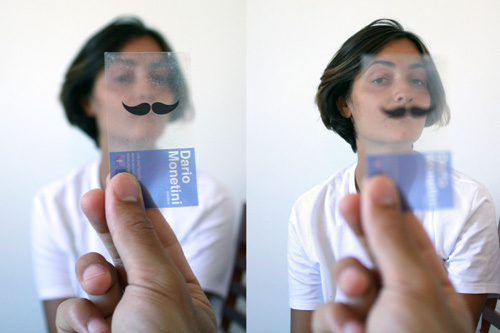
Image Source
Graphic designer Dario Monetini encourages people to have fun with his business cards — and he has some with sunglasses on them, too, if you want your friends to look even cooler than they already do.
4. Erase Last Night’s Mistake
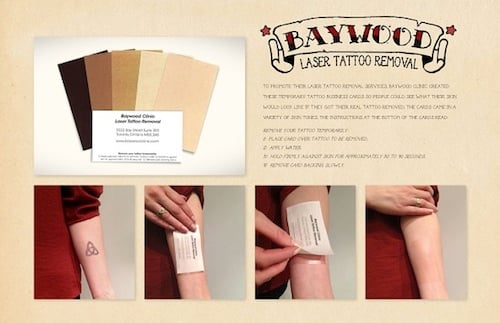
Image Source
If you ever wonder what you‘d look like if you hadn’t gotten that ink, this business card from Baywood Laser Tattoo Removal gives you a quick glimpse. Also great for job interviews and meeting the in-laws.
5. Check Your Tire Treads

Image Source
1010Tires created incredibly useful business cards with a direct tie-in to their business — keep this business card on you, check your tread depth periodically, and come see us when you need new tires. Brilliant.
6. Which One’s Better: This, or This

Image Source
Similarly functional, this optometrist turned her business card into an eye chart. If you’re having trouble making out any of the rows, make an appointment.
7. Better Than Duct Tape
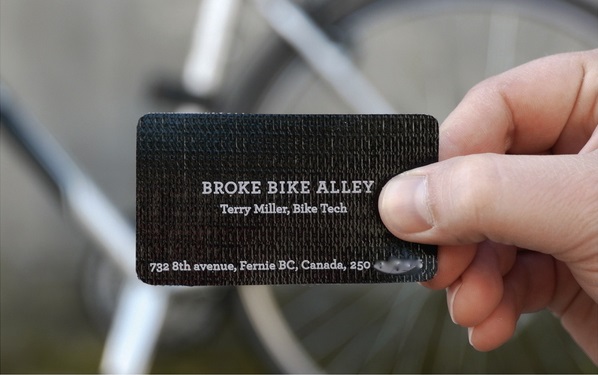
Image Source
Any avid biker would keep this business card from Broke Bike Alley handy — it doubles as a patch for your tires.
8. Nom Nom Nom

Image Source
This is a business card made out of beef jerky — how cool is that? Unless you get really hungry or forget to take BC Adventure’s survival training courses, you could probably hold on to this for a while. (Anyone know how long beef jerky stays good for?)
9. C’mon, Folks, Pretend You Like Each Other (Yuk Yuk)

Image Source
This is a totally inbound business card from Vorderman Photography. Try to crop your photos with this free tool, and you’ll soon realize you’d rather leave it to the professionals.
10. Emergency Cheese Grater
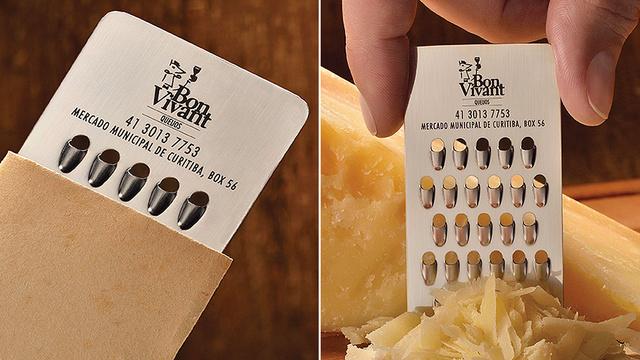
Image Source
I’ve actually been in this emergency before. Block of cheese, no way to shred it. And I thought I was so gourmet, not buying pre-shredded.
11. This Message Will Self Destruct In…
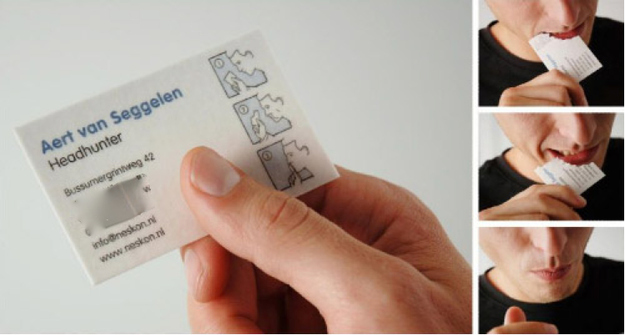
Image Source
This Dutch headhunter created an edible business card. So I guess if he gives it to you, the expectation is that you have to eat it.
I think that‘s how it works. This is truly outstanding, and technically, you’re not throwing anything away — it’s nourishment.




